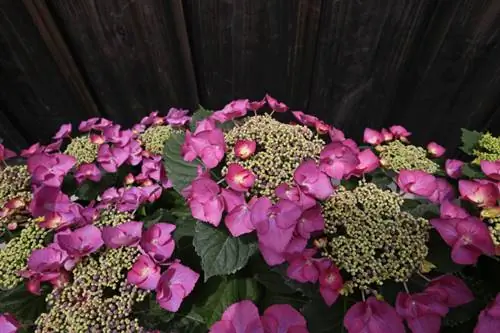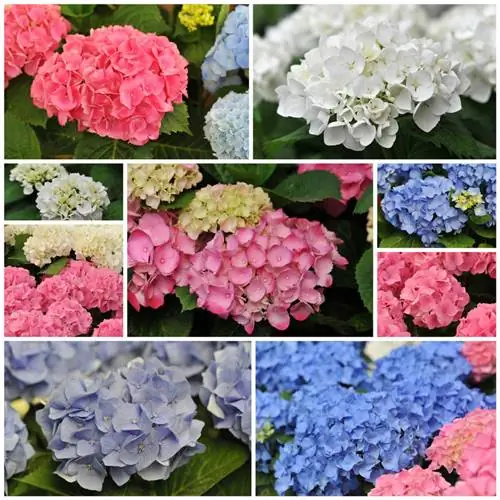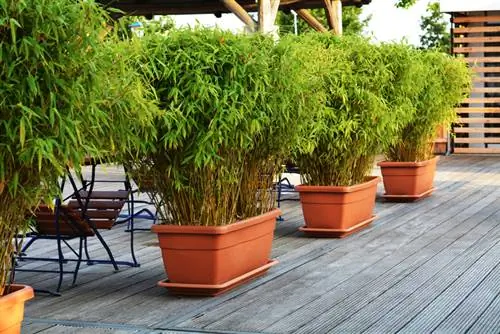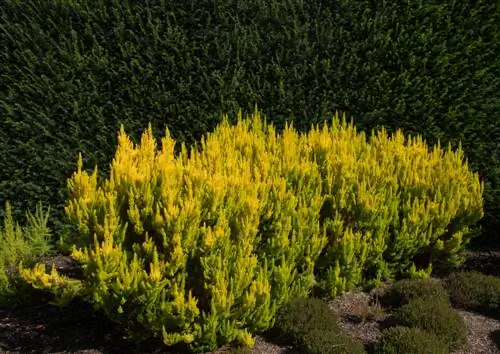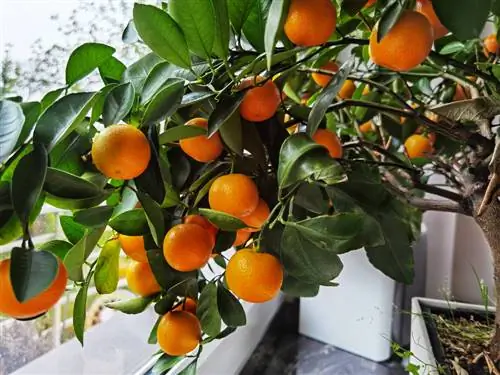- Author admin [email protected].
- Public 2023-12-16 16:46.
- Last modified 2025-01-23 11:20.
The hydrangea, also known as hydrangea or water shrub, enchants the garden with its romantic-looking flower balls. If you offer the hydrangea the optimal living conditions, the small flower bush that you once purchased and lovingly used will develop into an attractive flowering shrub with nostalgic charm. You can find out what you need to consider when planting hydrangea in this article.
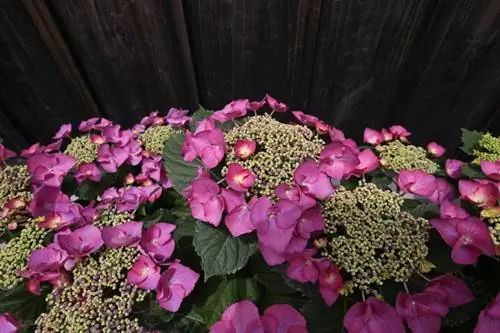
How do I plant hydrangeas correctly?
To plant hydrangeas correctly, ideally choose autumn or late spring as the planting time. Make sure you choose a sunny to partially shaded location and loose, slightly acidic soil. Dig a planting hole twice the size of the root ball and plant the hydrangea no deeper than ground level.
When is the optimal planting time?
If possible, you should plant the hydrangea in autumn. Normally the soil is a little wetter at this time of year than in spring or summer and the moisture-loving plant finds the optimal conditions.
Towards the end of spring is also a good time to plant the shrub. However, be sure to wait for the ice saints so that there are no more frosts to be expected.
Container plants can be used all year round. However, you will then have to accept increased care in the first few weeks and months, as the hydrangea needs to be watered regularly.
Which location does the hydrangea prefer?
The water shrub prefers sunny to partially shaded locations. In order for the hydrangea to produce many flowers, it should be exposed to the sun for around six hours a day. Make sure that the flowering shrub is not in the blazing sun all day in the hot summer months, as the hydrangea evaporates a lot of moisture over its large leaf surface and then leaves the flowers and leaves drooping.
Give the hydrangea a place that is sheltered from the wind so that the large flower balls are not torn apart by gusts of wind.
Which substrate does the flowering shrub prefer?
The hydrangea is wrongly considered to be demanding when it comes to soil conditions. Although the small shrub loves nutritious, deep and slightly acidic soil, with appropriate care it thrives even in poor sandy soil. The hydrangea only tolerates very dry locations and calcareous soil poorly.
Humid or clay soils, on the other hand, are ideal because these soils store moisture very well. However, if you have clay soil, you should make sure that the soil is not too compacted. If hydrangea does not find ideal soil in your garden, you can improve the subsoil with rhododendron soil, mature leaf compost or peat.
How is the hydrangea planted?
Dig the planting hole about twice the size of the pot ball. This allows you to spread the roots out in the planting hole without having to squeeze them together. Loosen the surrounding soil well so that the plant can grow in quickly.
It is recommended to place the water bush in a container filled with water for a few minutes before planting. This means that the root ball soaks up moisture and the plant can store enough water. Do not plant the hydrangea deeper than ground level so that the roots get enough air and develop quickly.
What distance should you keep from other plants?
The planting distance depends on which type of hydrangea you have chosen and whether hydrangea decorates the garden as a flowering hedge or an attractive solitary shrub. In general, a planting distance of at least 80 to 150 centimeters is recommended.
Can hydrangeas be transplanted?
If the hydrangea has to be moved in the garden, you should move the plant in autumn if possible or alternatively in late spring. Hydrangeas form very deep roots with many fine root fibers that should not be damaged too much. Therefore, dig up the roots within a wide radius around the plant in order to preserve the entire root ball if possible.
When transplanting, proceed in the same way as with newly purchased hydrangeas. Please note, however, that the planting hole is large enough to hold the entire root ball so that the root system does not have to be squeezed into it.
Good and bad neighbors
Blooming hydrangeas and rose bushes are a fantastic sight. Both plants get along very well and form harmonious plant communities. Hydrangea does not appreciate the direct proximity to lavender, which is often planted around roses to drive away lice.
Hydrangeas form an attractive community with bamboo, grasses and leafy plants, which also love partial shade. The hydrangea also feels at home in the vicinity of magnificent spars, hostas or autumn anemones.
Can hydrangeas be propagated yourself?
Since the colorful flowers of the hydrangea are usually only false flowers, propagation by seeds is often difficult for the layperson. It is easier to breed using cuttings, which can be done relatively easily.
To do this, cut off young shoots without buds from the flowering small bushes in spring or early summer. You can root the sprouts either in pots with potting soil or in water. After about two weeks, the first roots will form and the cuttings grown in the water glass can be transplanted into soil.
Some types of hydrangeas form shoots on the sides, which you can cut off and insert directly. The following applies to all young plants: In the first winter, the small plants should be brought into the house to overwinter in a frost-free place.
When does the hydrangea bloom?
The main flowering time of the hydrangea is from June to September. Depending on the species, it then bears spherical flower balls, flat umbels or inflorescences that look like elongated panicles.
Tips & Tricks
Soil conditions and location not only play a role in ensuring good growth. If an originally pink-flowering hydrangea is planted in soil with a pH value between 4.0 and 4.5, the flower color changes and the hydrangea develops rich blue flowers.

